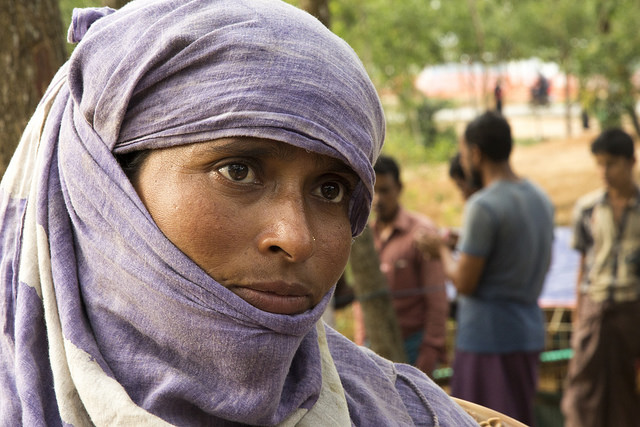7 Facts About the Rohingya Genocide
 The Rohingya crisis in Myanmar is not just persecution, but a genocide. According to an April 2018 Al Jazeera feature article, Myanmar has taken part in “ethnic cleansing” of the Rohingya people by not recognizing the group as people and stripping away basic human rights such as food, shelter and clothing. There is also extreme military violence to eradicate the Rohingya, which has led to seeking refuge in neighboring countries such as Bangladesh, India, Thailand and Saudi Arabia.
The Rohingya crisis in Myanmar is not just persecution, but a genocide. According to an April 2018 Al Jazeera feature article, Myanmar has taken part in “ethnic cleansing” of the Rohingya people by not recognizing the group as people and stripping away basic human rights such as food, shelter and clothing. There is also extreme military violence to eradicate the Rohingya, which has led to seeking refuge in neighboring countries such as Bangladesh, India, Thailand and Saudi Arabia.
7 Facts About the Rohingya Genocide
- The Rohingya have lived in Myanmar for centuries. They speak Ruaingga, which is distinct to other Myanmar languages, and they are primarily Muslims. According to Nicholas Kristof of The New York Times, evidence of a 1799 document shows that the Rohingya have resided in Myanmar since the 18th century and possibly earlier, considering the earliest records of Muslims in Myanmar are from the 12th century. Today, there are 1.1 million Rohingya living in Buddhist Myanmar.
- The Rohingya have had no state identity since 1982. The British rule (1824-1948) considered Myanmar as a province of India, and there was a high volume of Indian and Bangladeshi migration of laborers to Myanmar, which was considered an internal migration. After independence from the British, the Myanmar government recognized the migration as illegal. According to a 2015 report from the International Human Rights Clinic at Yale Law School, The Union Citizenship Act was passed in 1948 following independence, and the Rohingya were not included. A 1962 military coup required citizens to obtain national registration cards, and the Rohingya were only given foreign identity cards, which limited jobs and educational opportunities. In 1982, a new citizenship law was passed, which did not recognize the Rohingya as one of Myanmar’s 135 ethnic groups.
- Religious violence plays a large role in the tension between the Rohingya and the Myanmar government. Since 1982, the Rohingya have been persecuted and victims of violence. The Rohingya make up 2 percent of Buddhist Myanmar’s population but represent the largest percentage of Muslims in Myanmar. Often overlooked, religious violence has been key in the tension between the Rohingya and the military. In 2012, Muslim men had allegedly raped a Buddhist woman, which created massive religious violence against the Rohingya, forcing about 140,000 into camps for internally displaced people. According to CNN, from August to September 2017 alone, 6,700 Rohingya were killed by the Myanmar government while 2,700 died from disease and malnutrition.
- The majority of the Rohingya live in the Rakhine state, one of the poorest states in Myanmar, and it is illegal for the Rohingya to leave. In addition, 362 villages have been destroyed by the military. Rakhine is filled with “ghetto-like camps” and lacks access to education, healthcare, services, homes, water, etc., stripping the people of basic human needs.
- Aung San Suu Kyi, Nobel Peace laureate and Burmese leader, has kept quiet on the genocide. Aung San Suu Kyi has neither criticized nor praised the Myanmar government for the genocide and does not recognize the Rohingya as an ethnic group. The Myanmar military claims it “maintains peace and stability,” although the U.N. states that the Myanmar military has committed crimes against humanity. Aung San Suu Kyi and her government, in fact, recognize the Rohingya as terrorists, in particular to the Arakan Rohingya Salvation Army.
- The U.N. states that the Rohingya genocide is the “world’s fastest-growing refugee crisis.” UNICEF estimates 687,000 have sought refuge dangerously by boat, primarily in neighboring Bangladesh, and over half of them are child refugees. However, Bangladesh has presented resistance to the refugees, because a poor, densely populated country such as Bangladesh will be unable to sustain them. In August 2017, the U.N estimated that there are at least 420,000 Rohingya refugees in Southeast Asia. Additionally, there are around 120,000 internally displaced Rohingya. An estimated half a million Rohingya are still in Myanmar.
- International aid has provided 700,000 Rohingya with food, and aid is imperative to save the ethnic group. International help has greatly impacted the Rohingya community. In addition to food, countries, such as Pakistan and India, have helped with providing refugee camps for the Rohingya. Almost 100,000 people have been treated for malnutrition. By January 2018, 315,000 children have been vaccinated for diphtheria, tetanus and whooping cough. The U.K. has provided 59 million euros for those fleeing Myanmar, and the U.N. Security Council has appealed to Myanmar to stop the violence against the Rohingya.
The Rohingya genocide is described as “the world’s most persecuted minority.” Myanmar is committing crimes against humanity with ongoing violence, refugees, disease, malnutrition, poverty, etc. The Rohingya genocide must be seen through a humanitarian and moral lens to put an end to the atrocities being committed.
– Areina Ismail
Photo: Flickr
